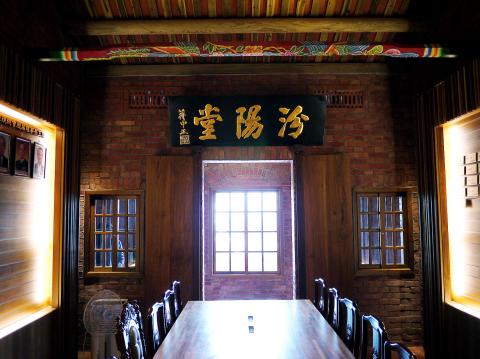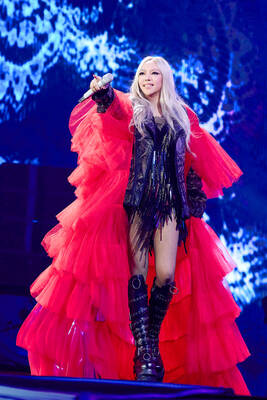The first thing that comes to mind when talking about Taipei’s Neihu District may be the Neihu Technology Park, teeming with modern high-rise office buildings. That, however, is not the whole picture of Neihu. Admired for its beautiful mountain and lake scenery, Neihu is also home to several historical sites. Among them, the newly renovated Guo Ziyi Memorial Hall — formerly the Neihu Guo Family Estate, also known as Neihu’s “Red House” — has been officially open to the public since Feb. 3. It was established in honor of a Tang Dynasty statesman Guo Ziyi (697-781), known for his impressive feats 1,250 years ago.
Guo Ziyi — the ancestor of the world’s Guo (often spelled “Kuo” in Taiwan) clan — earned his fame for ending the An Shi Rebellion in 755 and other disturbances and served under four Tang emperors, namely the Xuanzong, Suzong, Daizong, and Dezong emperors. In 762, Guo was made Prince of Fenyang for his achievements. In addition, there is an anecdote about Guo Ziyi in a popular Peking opera titled “Hitting the Princess While Drunk,” which tells of the harmonious and intellectual relationship between him and the Daizong Emperor.
Built in 1917, the 130-ping (426.2m2) two-story Western-style red-brick house spreads out over a 360-ping (1,178m2) area. The roughly T-shaped building was decorated with washed terrazzo, earthen sculptures, colored tiles imported from Japan, and Baroque-style embellishments. The red bricks are larger (about 4 inches) and denser than those of today. The floors were made of wood and supported by a good number of fir wood beams. There were also painted beams for hanging traditional Taiwanese censers and lanterns. The windows on the front facade are in different shapes, and there is an arc-shaped balcony and a charming Baroque-style balustrade with charming curves on top of the wall. A statue of Guo Ziyi is placed in the main hall. A variety of historical documents are on display, including the Tang poet Li Bai’s poem in praise of the Prince of Fenyang, rubbings from Tang Dynasty tablets by the Prince of Fenyang, and other calligraphy works and paintings. In addition, Fenyang wine and miniature figurines of Guo Ziyi are sold in the hall.

Photo: Lin Ya-ti, Taipei Times
照片:台北時報林亞蒂
The Guo Ziyi Memorial Hall was the home of the first Neihu Village mayor Kuo Hua-jang during the Japanese colonial era, and it was designated as a municipal historical heritage site by the Taipei City Government in 1999. Despite being designated as a historical site, the house continued to be neglected for more than a decade. Thank to the efforts of the World Guo’s Clan Association President Kuo Shih-chi, starting October, 2010, the house was given a year-long facelift by Guo Ching-po — another member of the Guo clan and a master craftsman specialized in the restoration work of historical sites. The total renovation cost was approximately NT$50 million. The World Guo’s Clan Association donated more than NT$30 million of these funds and the Taipei City Government provided more than NT$10 million. Today, the once dilapidated house is coming back to life once more, inviting people to appreciate the beauty of its architecture and soak up the ambience of times gone by. Admission to the Guo Ziyi Memorial Hall is free and the hall is closed every Monday. Address: 19, Ln 267, Wende Rd, Neihu District, Taipei. Tel: (02) 2659-8787.
(Lin Ya-ti, Taipei Times)
說到台北市內湖區,腦海可能會出現現代辦公大樓林立的內湖科技園區,但這並非內湖的全貌。好山好水的內湖,也富含人文古韻,坐擁多處古蹟,其中位於捷運文德站一號出口旁的小山丘上,就藏著一棟剛修建完成素有「內湖紅樓」之稱的內湖郭氏古宅,二月三日正式以「郭子儀紀念堂」之名對外開放,紀念唐朝軍事政治家郭子儀(西元六九七至七八一),在一千兩百五十年前的豐功偉績。
郭子儀是世界郭氏宗親先祖,曾平定西元七五五年的安史之亂以及諸多亂事,戰功彪炳,歷事唐朝玄、肅、代、德四帝,於西元七六二年被封為汾陽郡王。另外,中國民間戲曲有一齣膾炙人口的傳統曲目《醉打金枝》,即是講述唐代宗與郭子儀君臣之間相處圓融與智慧的趣聞軼事。

Photo: Lin Ya-ti, Taipei Times
照片:台北時報林亞蒂
這棟建於一九一七年以紅磚堆砌而成的一百三十坪(四百二十六點二平方公尺)兩層洋樓,占地三百六十坪(一千一百七十八平方公尺)。建築平面略呈T字形,有洗石子、泥塑、日本進口彩瓷,以及巴洛克繁飾。磚頭比起現代用的紅磚來得大(約四吋)且密度更高。室內樓板為木造,以眾多杉木木樑支撐,另外還有彩繪燈樑,可懸掛台灣傳統的天公爐與燈籠。正立面的窗子形式富變化,弧形陽台,山頭造型仿巴洛克風格,富捲草曲線之美。郭子儀像供奉在正廳,而周圍則展示著各式文物,包含唐朝詩人李白的《汾陽王贊》、唐代碑刻《汾陽王置寺表》拓本,以及各式書畫。除此以外,館內還販售汾陽酒與郭子儀迷你公仔。
「郭子儀紀念堂」原是內湖在日據時期首任庄長郭華讓的宅第,一九九九年被台北市政府列為市定古蹟,但這棟年久失修的古蹟,繼續被閒置十多年,直到二○一○年十月,在世界郭氏宗親總會理事長郭石吉的努力下,由古蹟匠師同時也是郭氏宗親的郭清波承攬修建工程,修復工程總共耗資新台幣五千萬元,其中郭氏宗親認捐三千多萬,而台北市政府則補助一千多萬。歷經一年多的修復努力,原來破舊不堪的古厝,如今再度被賦予生機,吸引民眾前來領略其建築之美、發思古之幽情。「郭子儀紀念堂」免費參觀,每週一休館。地址:台北市內湖區文德路二六七巷十九號。電話:(02) 2659-8787。
(台北時報記者林亞蒂)

Photo: Lin Ya-ti, Taipei Times
照片:台北時報林亞蒂

Photo: Lin Ya-ti, Taipei Times
照片:台北時報林亞蒂

Photo: Lin Ya-ti, Taipei Times
照片:台北時報林亞蒂

Photo: Perry Svensson, Taipei Times
照片:台北時報蘇沛

詞法—不定詞的誤用 1. 我得記住星期五要把報告寫好。 ˇ I must remember to finish my report by Friday. χ I must remember finishing my report by Friday. 註︰remember 後面跟動名詞或不定詞表示兩種不同的概念,與 forget 相類似。 試比較下列句子: I remember meeting him somewhere.(我記得曾經在某處見過他。) I must remember to meet him at the station at six this evening. (我必須記住今晚六點得去車站接他。) He remembered turning off the light when he left the room. (他記得離開房間時曾先把燈熄了。) Remember to turn off the light when you leave the room. (記住離開房間時要把燈關了。) 2. 他提醒她做好她份內的事。 ˇ He reminded her to do her job. χ He reminded her of doing her job. 註︰remind ... of ... 後面跟動名詞,表示「使人想起做過某事」。若是「提醒某人應做某事」,應用 remind ... to do ...。試比較下列句子: He reminded me of my attending the lecture last Friday. (他讓我想起我上星期五去聽過那次演講。) He

A: Happy New Year! I can’t believe it’s 2026 already. Where did you count down? B: I went to pop singer A-mei’s Taitung concert yesterday for the New Year’s countdown. How about you? A: I went to rock band Mayday’s Taichung concert yesterday. Going to their New Year’s shows has become a holiday tradition for me. B: Don’t forget, we’re also going to Jolin Tsai’s show tonight. It’s her first perfomance at the Taipei Dome. A: Yeah, that’s right. It’s great to start the year with good friends and good music. A: 新年快樂!我真不敢相信都已經2026年了。你昨天去哪跨年啦? B: 我昨天去了流行天后張惠妹的台東演唱會,還和她一起跨年倒數。那你呢? A:

★ Bilingual Story is a fictionalized account. 雙語故事部分內容純屬虛構。 “Any New Year’s resolutions?” he asked. Lena put her coffee down. “Yeah,” she said. “To get in shape.... round is a shape, right?” Mark chuckled. “I support this. Fully achievable. Low risk.” “Thanks,” she smiled and lovingly rubbed her round belly. “I like a resolution I can’t fail.” “Funny thing is, I was thinking about getting round too.” Lena nodded her head in approval, “You could put some meat on those skinny bones of yours.” Mark shook his head, “Not that kind of round. Wheel-of-Life round.” She raised an eyebrow.

A: Apart from Taiwan’s A-mei, Mayday and Jolin Tsai, there are many foreign singers coming to Taiwan early this year. B: The South Korean girl group Babymonster are playing two shows at Taipei Arena starting from tonight. Who else is coming to Taiwan? A: Other artists include Australian band Air Supply, K-pop superstar Rain, boy group Super Junior, TXT, US singers Giveon and Josh Groban, and Irish boy group Westlife. B: Air Supply was the first foreign band to come to Taiwan in 1983, and they’re probably the most frequently visiting group too. A: As the year is beginning